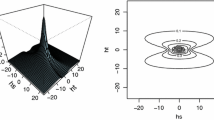Abstract
The past two decades have witnessed an increasing interest in the use of space-time models for a wide range of environmental problems. The fundamental tool used to embody both the temporal and spatial components of the phenomenon in question is the covariance model. The empirical estimation of space-time covariance models can prove highly complex if simplifying assumptions are not employed. For this reason, many studies assume both spatiotemporal stationarity, and the separability of spatial and temporal components. This second assumption is often unrealistic from the empirical point of view. This paper proposes the use of a model in which non-separability arises from temporal non-stationarity. The model is used to analyze tropospheric ozone data from the Emilia-Romagna Region of Italy.
Similar content being viewed by others
References
Bakhsh A, Jaynes DB, Colvin TS, Kanwar RS (2000) Spatiotemporal analysis of yield variability for a corn soybean field in Iowa. Trans ASABE 43: 31–38
Bochner S (1955) Harmonic analysis and the theory of probability. University of California, Berkeley and Los Angeles
Bruno F (2004) Non-separability in space-time covariance functions, Ph.D thesis, Department of Statistics, University of Bologna
Carroll RJ, Chen R, George EI, Li TH, Newton HJ, Schmiediche H, Wang N (1997) Ozone exposure and population density in Harris County, Texas. J Am Stat Assoc 92: 392–404
Cocchi D, Trivisano C (2002) Ozone. In: El-Sharaawi A, Piegorsch W(eds) Encyclopedia of environmetrics. Wiley, New York, pp 1518–1523
Cocchi D, Greco F, Trivisano C (2006) Hierarchical space-time modelling of PM10 pollution. Atmos Environ 41: 532–541
Cox WM, Chu S (1993) Meteorologically adjusted ozone trends in urban areas: a probabilistic approach. Atmos Environ 27: 425–434
Cressie N (1993) Statistics for spatial data. Wiley, New York
Cressie N, Huang HC (1999) Classes of nonseparable, spatio-temporal stationary covariance functions. J Am Stat Assoc 94: 1330–1340
Damian D, Sampson PD, Guttorp P (2000) Bayesian estimation of semi-parametric non-stationary spatial covariance structure. Environmetrics 12: 161–176
De Cesare L, Myers D, Posa D (1997) Spatial-temporal modeling of SO2 in Milan district. In: Baafi EY, Schofield NA(eds) Geostatistics wollongong ’96, vol 2. Kluwer Academic Publishers, Dordrecht, pp 1031–1042
Diggle PJ, Tawn JA, Moyeed RA (1998) Model based geostatistics. Appl Stat 47: 299–326
Dimitrakopoulos R, Luo X (1997) Joint space-time modeling in the presence of trends. In: Baafi EY, Schofield NA(eds) Geostatistics wollongong ’96, vol 1. Kluwer Academic Publishers, Dordrecht, pp 138–149
Dryden IL, Márkus L, Taylor CC, Kovács J (2005) Non-stationary spatiotemporal analysis of karst water levels. Appl Stat 54: 673–690
EPA Environmental Protection Agency (1998) EPA’s updated air quality standards for smog (ozone) and particulate matter. http://www.epa.gov/ozonedesignations/
European Community (1996) Council directive on ambient air quality assessment and management 96/62/EC. OJ No L 296/55–63
Fassó A, Negri I (2002a) Nonlinear statistical modelling of high frequency ground ozone data. Environmetrics 13: 225–241
Fassó A, Negri I (2002b) Multi step forecasting for nonlinear models of high frequency ground ozone data: a Monte Carlo approach. Environmetrics 13: 365–378
Fassó A, Cameletti M, Nicolis O (2007) Air quality monitoring using heterogeneous networks. Environmetrics 18: 245–264
Fuentes M (2005) Testing for separability of spatial-temporal covariance functions. J Stat Plan Inference 136: 447–466
Gneiting T (2002) Nonseparable, stationary covariance functions for space-time data. J Am Stat Assoc 97: 590–600
Guttorp P, Meiring W, Sampson PD (1994) A space-time analysis of ground-level ozone data. Environmetrics 5: 241–254
Jaynes DB, Colvin TS (1997) Spatiotemporal variability of corn and soybean yield. Agron J 89: 30–37
Kyriakidis PC, Journel AG (1999) Geostatistical space-time models: a review. Math Geol 31: 651–684
Mitchell MW, Genton MG, Gumpertz ML (2006) A likelihood ratio test for separability of covariances. J Multivar Anal 97: 1025–1043
Roberts GO, Kareson K, Brown P, Tonellato S (2000) Blur-generated non-separable space-time models. J R Stat Soc, Ser B 62: 847–860
Rodriguez-Iturbe I, Mejia JM (1974) The design of rainfall networks in time and space. Water Resour Res 10: 713–728
Rouhani S, Myers DE (1990) Problems in space-time kriging of geohydrological data. Math Geol 22: 611–623
Sampson PD, Guttorp P (1992) Nonparametric estimation of nonstationary spatial covariance structure. J Am Stat Assoc 87: 108–119
Scaccia L, Martin RJ (2005) Testing axial symmetry and separability of lattice processes. J Stat Plan Inference 131: 19–39
Smith RL, Huang LS (1993) Modeling high threshold exceedances of urban ozone. Technical Report, 6, National Institute of Statistical Sciences, Research Triangle park
Author information
Authors and Affiliations
Corresponding author
Rights and permissions
About this article
Cite this article
Bruno, F., Guttorp, P., Sampson, P.D. et al. A simple non-separable, non-stationary spatiotemporal model for ozone. Environ Ecol Stat 16, 515–529 (2009). https://doi.org/10.1007/s10651-008-0094-8
Received:
Revised:
Published:
Issue Date:
DOI: https://doi.org/10.1007/s10651-008-0094-8



